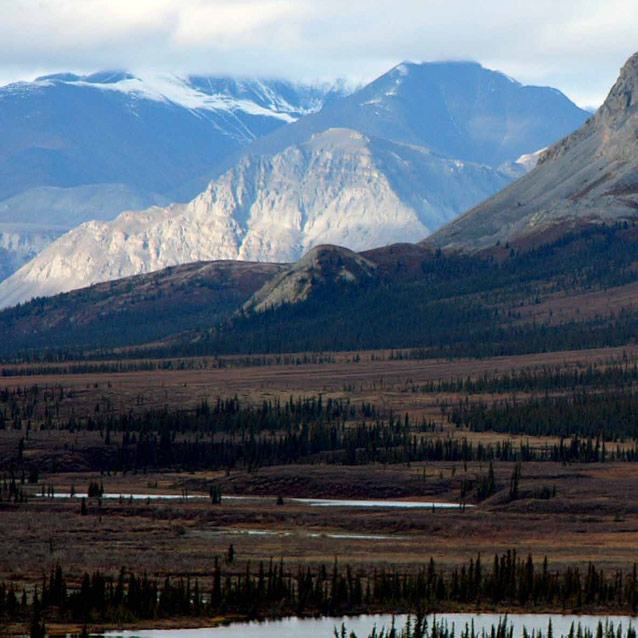
Sally Andersen/Arctic Wild
Simon Paneak, a Nunamiut hunter, spent most of his adult life living in Anaktuvuk Pass in the Brooks Range. Simon was a fountain of traditional ecological knowledge, as were other adults within his community. However, Simon spoke, read, and wrote English, which facilitated his long collegial relationships with a variety of researchers interested in Arctic cultural and biological ecosystems.
This article presents a brief overview of some of these research relationships but focuses on Simon’s work with Laurence Irving and their collaborative and long-term research agenda concerning the birds of Anaktuvuk Pass. “The Eskimo word Nunamiut, in fact, means “land people” (nuna = land; miut = people) or more particularly, inland people thus distinguishing them from other Eskimo tribes, the great majority of whom dwell on seashores” (Campbell 1998).
Nunamiut territory was approximately 66,000 square miles lying north of the tree line along the northernmost flanks of the Brooks Range extending less frequently into the Arctic slope. Before the middle of the nineteenth century the Nunamiut population was estimated to be 1,000-1,500 individuals sparsely distributed across their territory in 20 bands.
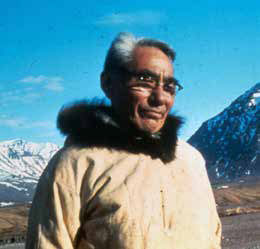
Photo courtesy of North Slope Borough Inupiat History, Language and Culture Department
The principle component of the Nunamiut diet was caribou. The remaining flora and fauna, including moose, mountain sheep, birds, fish, and plants were insufficient, even in the aggregate, to sustain Nunamiut populations for any length of time.
Large caribou herds in Arctic Alaska, such as the Western Arctic Caribou Herd (WACH), cycle through dramatic changes in herd size. For example, the WACH, according to Alaska Department of Fish and Game figures, were estimated to be 250,000 animals in 1970 but six years later were estimated to be 75,000 (Callaway 2005). Although these particular figures have been disputed, it is clear historically that the WACH has undergone drastic shifts in population. Most biologists think that, for a herd this size, the shifts are due to abiotic (e.g., climatic) events. However, one ethnographer, Gubser (1965) also felt herd size was dramatically decreased between 1890 and 1905 by Nunamiut hunters, who harvested huge numbers of caribou to trade to the whalers for rifles, ammunition, knives, tobacco, flour, tea and other items. Gubser also noted that during this period the Nunamiut suffered from a variety of epidemics, including flu, fevers and measles: "A flue and fever epidemic killed over a hundred Nunamiut at a feast at the upper Noatak River where Nunamiut, Noatak and Utukok Eskimos were trading
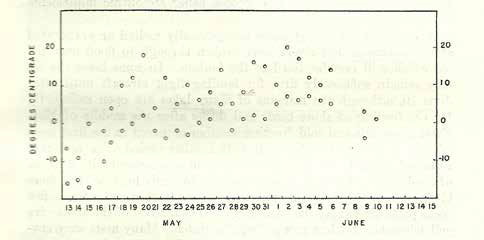
Image from Irving 1960
John Martin Campbell (1998) also cites Charles Brower, who witnessed the deaths of some 200 Nunamiut in 1899. The Nunamiut contracted a disease in Point Barrow and over the span of a few days died on their way back to the interior.
It was in this context of starvation and disease that Simon Paneak was born in 1900 in the Killik Valley of the central Brooks Range to a Nunamiut father and a mother from Point Hope. Simon grew to be a young man in the Brooks Range; however, by 1920 all the Nunamiut had either died of disease or, facing starvation, had migrated to the coast, which was rich with marine mammals. Simon resided on the coast for about 15 years. It was here that he married his first wife, a coastal Eskimo woman, trained by missionaries to be a schoolteacher. It was from her that Simon learned to speak, read, and write English. Some three decades later, Gubser (1965), during a long hunting trip, tells of Simon, recounting the death of his first wife in childbirth and his subsequent despondence lasting several years. In the mid-1930s as the trade value of furs declined, a few Nunamiut families returned inland to live their lives as caribou hunters among the headwater valleys of the central Brooks Range. One of these families included Simon and his second wife, Susie, a Nunamiut.
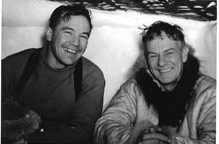
Photo courtesy of IAB
For slightly over a decade after his return to the Brooks Range, Simon lived the life of a subsistence hunter and continued to be a keen observer of the natural world. It is important to note that during this period Simon, like his congener Homer Mekiana, kept a journal; unfortunately, the contents of those journals have been lost to us. It is also important to realize that during the period of the 1940s Simon kept abreast of events in the world outside by listening to his mahogany-veneered Zenith all-wave receiving set—listening to “G.I. Jill,” “Voice of America,” and “Tokyo Rose.”
In 1945 at Chandler Lake, a plane piloted by Sig Wien dropped off a party of four geologists seeking to make stratigraphic maps of the area. Simon Paneak met the group, and thus began a long series of professional relationships between Simon and a variety of Arctic researchers. In 1947 Wien brought the noted Arctic physiologist Laurence Irving, who had decided that the nearby passes, based on information relayed by Charlie Brower and others, was a likely route for migrating birds. After initial meetings, Irving became increasingly impressed with Simon’s diligence, memory, and knowledge of the natural area. Irving said in his memorial article about Simon:
Numbers and dates characterized his observations and provided exact communication from his remarkable memory. This accuracy of memory fixed the position and appearance of geographical features, so that he could sketch maps free-hand of coasts and streams that he had not seen for years. (1976)
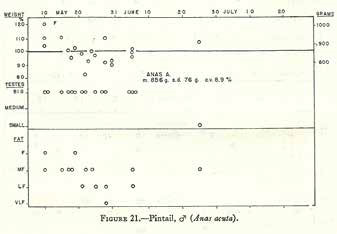
Image from Irving 1960
Irving dramatically underscores the acuity of Simon’s memory. In a passage in his book he tells the following anecdote:
In the winter of 1908 or 1909 (when Simon was 8 or 9 years old), Simon Paneak recalled, he and some other boys, who were then near the head of the west branch of the Kuparuk River (lat. 68° 35’ N., long. 149° 20’ W.) found over a hundred mud nests built against the rock cliffs. When these were knocked down or examination they were found to contain frozen young birds, which were well feathered and nearly ready to fly when they had died. Paneak and I discussed this story again as we watched the cliff swallows building their nests against the houses at Bettles. (1960)
In 1950 Irving asked Simon to initiate a journal on birds, which Simon did until his death in 1975. In this journal, after consultation with Irving, Simon made systematic observations on the number and sex of all specimens collected; the date on which they were collected; weight in grams; fatness on a scale ranging from fat (F), medium fat (MF), little fat (LF), to very little fat (VLF); and where important, certain measurements.
Simon performed these and other observations such as taking the temperature at 8 am every morning for a year (Irving 1960) or the high and low temperature every day for the month of May and June in 1951. In addition, Simon recorded for years the first arrival of nesting and migrating birds by species. In 1951 Krog (a colleague of Irving’s) and Paneak carefully observed the arrivals and obtained weights of over 500 birds during a spring season that started slightly earlier, was drier, and was more variable in weather than usual.
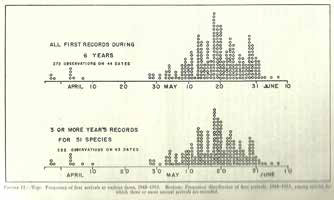
Image from Irving 1960
Simon’s journals were detailed:
…from May until fall the journals focus on the migratory birds that nest in the Arctic, Simon tallies the sightings of different species reported by himself and other family members; he notes when birds are singing and mating, he comments on their nests and eggs, and when the young of various species first take flight. Over the years he collected numerous bird specimens for Irving, recording, in his journal the weight, length, and sex of each along with the contents of their crops (Blackman 2004).
Numerous tables in Irving’s book are a direct consequence of Simon’s careful observations and documentation. For example, one figure in Irving’s book documents first arrivals at Anaktuvuk from 1948 to 1953 for 69 species of migrant birds and also provides detailed information on nesting and egg laying. This data is further refined in another figure where the frequency of first arrivals is plotted against month and day from April through June (1948).
Previous to this Simon’s observations provided the data necessary to classify the status of 106 species of birds as to whether they were resident, resident and migrating, migrating to nest, visitor, or winter visitor (Irving 1960).
In 1960, shortly after the beginning of Simon’s intensive ethnographic work with Nicholas Gubser, Irving requested that Simon concentrate his observations on willow ptarmigan. As Blackman (2004) states, “by 1963 his journals are dominated by ptarmigan.” Blackman writes, “They (notes on ptarmigan) appear by the hundreds, by the thousands. Simon’s activities are focused on tracking every one of theirs and they loom so large on the landscape that one wonders how anyone could discuss the Arctic without mentioning ptarmigan.”
From these detailed notes and observations comes one of Simon’s major scientific publications, Migration of Willow Ptarmigan in Arctic Alaska (Irving et al. 1967). Interestingly, Cornell Lab’s Birds of North America, the go-to source for a current overview of North American bird species written by Hannon et al. (1998), cites this article no fewer than three times, noting it as a major source on migratory behavior, including flock size and winter range. It also serves as a singular source on food capture and consumption (i.e., Simon’s analysis of crop content).
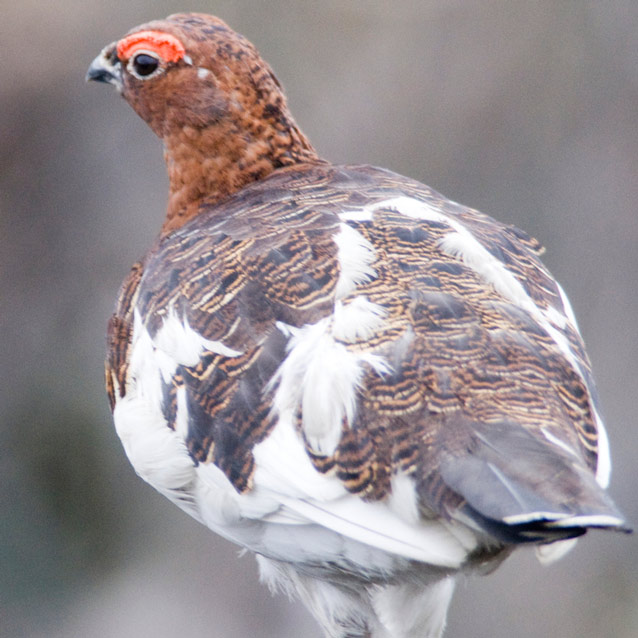
NPS Photo
Hannon et al. (1998) raise several key issues concern-
ing willow ptarmigan in their section “Priorities for Future Research”:
- However, the relative remoteness of their habitats, the harsh weather conditions in autumn and winter, and shrinking research budgets in governments and universities have left a number of research questions unresolved.
- There is a need for cross-disciplinary work with archaeologists and anthropologists to determine changes in distribution and habitats occupied historically.
- Finally, we need to determine responses of Willow Ptarmi- gan to global environmental changes such as the impact of climate change on distribution, abundance and breeding.
With respect to the unresolved research questions, Simon and Irving’s partnership was a fairly inexpensive approach and the only real way to have a researcher on the ground every day of the year. As Irving says:
Their hospitality has greatly eased the burden of working in remote regions while their extensive knowledge of the movements of the various birds has helped me to distinguish the regularity common to populations from the deviations of occasional individuals (1960).
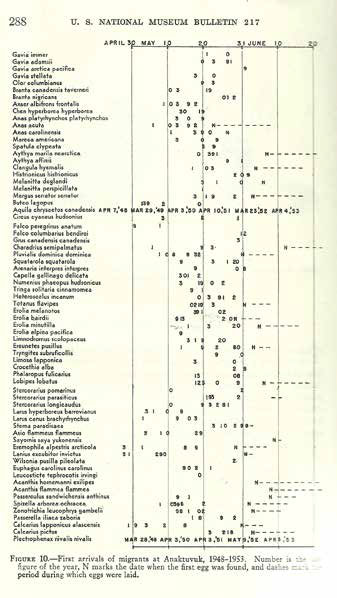
Image from Irving 1960
Their research design included Stephen C. Porter, a field geologist; Loren D. Potter, a plant ecologist; James E. Morrow, an ichthyologist; and Robert L. Rausch, a mammalogist and parasitologist. Simon Paneak served as both a field associate and long-distance adviser to all of them. About Simon Paneak, Campbell summarizes:
Throughout his life he had taken special interest in Nunamiut cultural and natural history. He was expert in native technology and in the manufacture of its artifacts. He had extraordinary knowledge of Brooks Range flora and fauna; so extraordinary, in fact, that our colleague the physiologist Laurence Irving, once remarked to us that had Paneak belonged to our society he undoubtedly would have been a professional biologist (1998).
One quick example of the complementary nature of interdisciplinary research revolves around the issue of the utility of willow ptarmigan to the Nunamiut diet. Irving, a physiologist, and Campbell thought that despite the availability of ptarmigan during the winter, the birds’ low fat content made them an insignificant contribution to the Nunamiut diet. Gubser (1965), however, following up on this topic, found that willow ptarmigan were an important supplement to the diet in late spring when food from other sources was in extremely short supply. In addition, in the 1960s “many Nunamiut still set snares for ptarmigan day after day during the lean months of the winter” (Gubser 1965). Gubser continues:
Many Nunamiut speak of the ptarmigan as an invaluable dietary supplement, especially in hard times which are not unusual in the Brooks Range. The only problem with ptarmigan, however, is that they have very little fat, and eating boiled ptarmigan without blubber or fat of some kind ‘is like eating moss.’ Many older Nunamiut can remember a winter when, if there had been no ptarmigan, some people would have starved to death.
To this point we have concentrated on Simon’s work with Irving on birds that resulted in three peer-reviewed articles with Simon as a junior author and Irving’s book Birds of Anaktuvuk Pass, Kobuk, and Old Crow (1960). However, we would be remiss not to mention Simon’s contribution to the ethnography of the Nunamiut.
In 1949, Helge Ingstad arrived in the Brooks Range and stayed with Simon for several months and then in 1989 when, at the invitation of the community, he returned to be celebrated for his contributions to their preservation of their cultural heritage. His book, Nunamiut, Among Alaska’s Inland Eskimos (1954), was a popular best seller, especially in his home country of Norway. A commemorative edition was published in 2006, with a preface by Grant Spearman (the preface is a must read). Ingstad was also instrumental in getting Dr. Knut Bergsland, a highly regarded linguist, to transcribe the texts of stories he had recorded from Simon. Simon’s stories were eventually published by the North Slope Borough as Nunamiut Stories. Finally, Helge’s (2006) description of a sheep hunt with Simon is not to be missed.
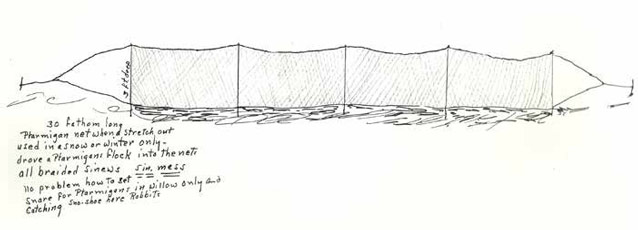
In addition, John Martin Campbell, a member of the 1956 Yale North Alaska Expedition, became a long-term friend, colleague, and collaborator with Simon for nearly 20 years. Campbell’s North Alaska Chronicle (1998) is a compilation of 62 drawings done by Simon with both individuals providing ethnographic notes as to their content. In addition, Campbell edited a book of essays by Simon, In a Hungry Country (2004). This book also contained contributions from Robert L. Rausch, Stephen C. Porter, and Grant Spearman; all but Grant were research collaborators who worked with Simon as described above.
Finally, the most definitive and detailed ethnographic work on the Nunamiut was written by Nicholas J. Gubser, entitled, The Nunamiut Eskimos: Hunters of Caribou (1965). Gubser, a precocious Yale senior, spent nearly a year with Simon Paneak in 1960. This is a remarkable and professional ethnography written by what was essentially an undergraduate student. Simon Paneak died in 1975 a cherished friend and colleague to multiple generations of Arctic researchers representing contributions to a broad span of disciplines.
References
Blackman, M., 2004.
Upside Down, Seasons among the Nunamiut, Lincoln: University of Nebraska Press.
Callaway, D., 2005.
ANILCA and the western Arctic caribou herd cooperative management plan. Alaska Park Science. 4:2.
Campbell, J. 1998.
North Alaska Chronicle, Notes from the End of Time. Santa Fe: Museum of New Mexico Press.
Gubser, N. 1965.
The Nunamiut Eskimos: Hunters of Caribou. New Haven: Yale University Press.
Hannon, S., P. Eason, and K. Martin. 1998.
The Birds of North America Online. Ed. A. Poole. Willow ptarmigan (Lagopus lagopus). Ithaca: Cornell Lab of Orni- thology. http://bna.birds.cornell.edu/bna/species/369 doi:10.2173/bna.369
Ingstad, H. 1954.
Nunamiut, Among Alaska’s Inland Eskimos. Special Commemorative Edition 2006. The Woodstock: Countryman Press.
Irving, L. 1960.
Birds of Anaktuvuk Pass, Kobuk, and Old Crow: A Study in Arctic Adaptation. Bulletin 217. Washington, D.C.: Smithsonian Institution.
Irving, L., and S. Paneak, 1954.
Biological reconnaissance along the Ahlasuruk River east of Howard Pass, Brooks Range, Alaska, with notes on the avifauna. Journal of the Washington Academy of Sciences. 44(7): 201-211.
Irving, L., G. West, L. Peyton, and S. Paneak. 1967.
Migration of Willow Ptarmigan in Arctic Alaska. Arctic. 20:77-85.
Irving, L., 1976.
Simon Paneak. Arctic. Vol. 29, No. 1:58-59.
Paneak, S., 2004.
In a Hungry Country: Essays by Simon Paneak. Ed. J. Campbell. Fairbanks: University of Alaska Press.
Part of a series of articles titled Alaska Park Science - Volume 14 Issue 2: Birds of Alaska's National Parks.
Last updated: November 1, 2022
